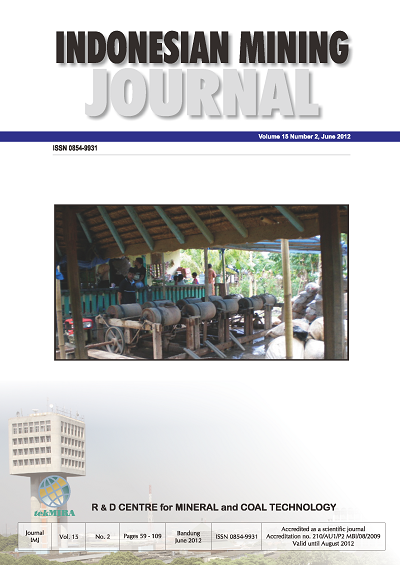STUDY OF BATCH SCALE-UP BENTONITE ACTIVATION USING SULFURIC ACID
DOI:
https://doi.org/10.30556/imj.Vol15.No2.2012.462Keywords:
batch scale-up, bentonite, activation, bleaching powerAbstract
As a commodity for industrial applications, bentonite is needed in a large number of tonnages. Indonesia retains about 6 hundred million tons of bentonite resources, but its quality does not yet satisfy industrial spesifi cation. Most Indonesian bentonite is calcium-bentonite type. Therefore, it is necessary to activate the material to en- hance its absorption ability for decolorizing crude palm oil in cooking oil industries. This research was aimed to obtain the optimal bleaching power in order to decolorize the crude palm oil effectively. The batch scale bentonite activation used raw material from Sarimanggu, Tasikmalaya district, West Java. Since 40 %-solid gave a better average bleaching power value than that of 20 %, the activation was then focused at seeking the best condition with regards to the activition time (hour) and reagent dosages (sulfuric acid). The batch up scale of this research refered to the use of a 100-kg bentonite as the feed. The feed size was -10 mesh. The use of sulfuric acid was
2.5 to 20 % (equivalent to 0.13 to 1.02 N) for 20 % solid and 2.5 to 15 % (equivalent to 0.34 to 2.04 N) for 40 % solid. A series of activation times was 1, 2, 3, 4, and 5 hours. It started when sulfuric acid has been depleted. Sampling was completed for each hour when a sample was neutralized until pH = 7. The sample was dried and the rest of bentonite slurry was fl owed into a dilution tank to be neutralized using water. Condition of 1-hour activation and 7.5 %-sulfuric acid (equivalent to 1.02 N) provided the best bleaching power value (88 %).
References
Bergaya, F., Theng, B.K.G., Lagaly, G., 2006. Hand- book of clay science. Elsevier Ltd, Oxford, United Kingdom, 1224 p.
Ciullo, P.A., 1996. Industrial minerals and their uses.
Noyes Publication, New Jersey, 632 p.
Daranin, E., and Haryadi, H., 2010. Potret industri berbasis bahan baku mineral (bentonit-kaolin- gamping). R & D Centre for Mineral and Coal Technology, Bandung.
Didi, M. A., Makhoukhi, B., Azzouz, A., and Villemin, D., 2009. Colza oil bleaching through optimized acid activation of bentonite. A comparative study. Applied Clay Science, p. 336.
Foletto, E.L., Colazzo, G.C., Volzone, C., and Porto, L.M., 2011. Sunfl ower oil bleaching by adsorption onto acid-activated bentonite, Brazil. Vol. 28, No. 01, p. 170.
Gupta, Kumar Rajendra, 1985. Industrial chemicals handbook. Small Business Publication, New Delhi, 781 p.
Husaini, 2001. Pembangunan pilot plant aktifasi ben- tonit dengan asam sulfat untuk penjernih warna CPO di daerah Karangnunggal, Tasikmalaya. R & D Centre for Mineral and Coal Technology, Bandung.
Husaini, 2002. Pemanfaatan bentonit sebagai bahan pemucat CPO, Skala pilot plant, Jawa Barat. R
& D Centre for Mineral and Coal Technology, Bandung.
Kirali, E.G., and Lacin, O., 2006. Statistical model- ing of acid activation on cotton oil bleaching by Turkish bentonite. Journal of Food Engineering, p. 137-141.
Miswanto, A., Sudrajat, A., Lukman, A., Haryadi, H., Suhendar, and Sujono, 2006. Kajian bahan galian industri. R & D Centre for Mineral and Coal Tech- nology, Bandung.
Rossi, M., Gianazza, M., Alamprese, C. and Stanga, F., 2003. The role of bleaching clays and synthetic silica in palm oil physical refi ning. Food chemistry, p. 291-296.
Rozic, L. Novakovic, T., and Petrovic, S., 2010. Model- ing and optimization, process parameters of acid activation of bentonite by response surface meth- odology. Applied Clay Science, p. 154-158.
Suhala, S., and Arifi n, M., 1997. Bahan galian industri. R & D Centre for Mineral and Coal Technology, Bandung.
Zulkarnain, 1998. Pengkajian optimasi aktifasi bentonit dengan asam sulfat. R & D Centre for Mineral and Coal Technology, Bandung.
Downloads
Issue
Section
License
Indonesian Mining Journal provides immediate open access to its content on the principle that making research freely available to the public to supports a greater global exchange of knowledge.

This work is licensed under a Creative Commons Attribution-NonCommercial 4.0 International License.













